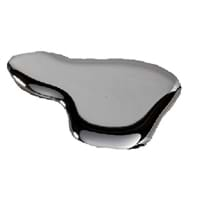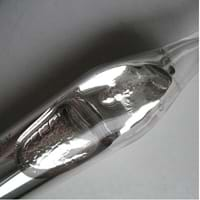Mercury Rubidium Comparison
Periodic Table
Symbol
Hg
Rb
Group Number
12
6
1
17
Period Number
6
5
Block
d block
s block
Element Family
Transition Metal
Alkali
CAS Number
7439976
99+
7440177
99+
Space Group Name
R_ 3m
Im_ 3m
Space Group Number
166.00
6
229.00
1
Facts
Interesting Facts
- At room temperature mercury is found in a liquid state.
- A coin of pound or rupees floats in mercury.
- Because of its low melting point and boiling point it is used in thermometers.
- Rubidium metal is 16th most common element found in the earth crust.
- Rubidium metal also found in minerals as well as seawater.
Sources
Mining, Ores of Minerals
Obtained from Lithium Production.
History
Who Discovered
Ancient Chinese and Indians
Robert Bunsen and Gustav Kirchhoff
Discovery
Before 2000 BCE
In 1861
Abundance
Abundance In Universe
Not Available
1 * 10-6 %
16
Abundance In Sun
~-9999 %
~0.000003 %
17
Abundance In Meteorites
Not Available
0.00 %
19
Abundance In Earth's Crust
0.05 %
9
0.01 %
18
Abundance In Oceans
Not Available
0.00 %
7
Abundance In Humans
Not Available
0.00 %
7
Uses
Uses & Benefits
- It is a liquid metal at room temperature, but it is a toxic heavy metal and hence many uses of mercury are under review or phased out.
- It is manly used as a catalysts in chemical industry.
- Rubidium's main application is in the glass manufacturing.
- Rubidium can very easily get ionized and hence it is used for ion engines, but it is still less efficient than that of Caesium.
Industrial Uses
Electrical Industry, Electronic Industry
NA
Medical Uses
Dentistry
NA
Other Uses
Alloys, Mirror Manufacturing, Pharmaceutical Industry
Alloys, Research Purposes
Biological Properties
Toxicity
Highly Toxic
Non Toxic
Present in Human Body
Yes
Yes
In Blood
0.01 Blood/mg dm-3
23
2.49 Blood/mg dm-3
7
In Bone
0.45 p.p.m.
19
5.00 p.p.m.
13
Physical Properties
Melting Point
Not Available
38.89 °C
99+
Boiling Point
356.58 °C
99+
688.00 °C
99+
Appearance
Physical State
Liquid
Solid
Color
Silver
Grayish White
Luster
NA
NA
Hardness
Mohs Hardness
Not Available
0.30
24
Brinell Hardness
Not Available
0.22 MPa
99+
Speed of Sound
1,451.40 m/s
99+
1,300.00 m/s
99+
Optical Properties
Refractive Index
1.00
3
Not Available
Reflectivity
73.00 %
8
Not Available
Allotropes
No
No
α Allotropes
Not Available
Not Available
β Allotropes
Not Available
Not Available
γ Allotropes
Not Available
Not Available
Chemical Properties
Chemical Formula
Hg
Rb
Isotopes
Known Isotopes
34
5
29
10
Electronegativity
Pauling Electronegativity
2.00
7
0.82
99+
Sanderson Electronegativity
2.20
7
0.31
32
Allred Rochow Electronegativity
1.44
17
0.89
40
Mulliken-Jaffe Electronegativity
1.81
9
0.69
24
Allen Electronegativity
1.44
30
0.71
99+
Electropositivity
Pauling Electropositivity
2.00
99+
3.18
3
Ionization Energies
1st Energy Level
1,007.10 kJ/mol
4
403.00 kJ/mol
99+
2nd Energy Level
1,810.00 kJ/mol
20
2,633.00 kJ/mol
6
3rd Energy Level
3,300.00 kJ/mol
20
3,860.00 kJ/mol
11
4th Energy Level
Not Available
5,080.00 kJ/mol
18
5th Energy Level
Not Available
6,850.00 kJ/mol
19
6th Energy Level
Not Available
8,140.00 kJ/mol
20
7th Energy level
Not Available
9,570.00 kJ/mol
20
8th Energy Level
Not Available
13,120.00 kJ/mol
17
9th Energy Level
Not Available
14,500.00 kJ/mol
18
10th Energy Level
Not Available
26,740.00 kJ/mol
6
Electrochemical Equivalent
3.74 g/amp-hr
10
3.19 g/amp-hr
14
Electron Work Function
4.49 eV
15
2.16 eV
99+
Other Chemical Properties
Flammability, Ionization, Solubility
Corrosion, Ionization, Radioactive Isotopes, Radioactivity
Atomic Properties
Atomic Number
80
36
37
99+
Electron Configuration
[Xe] 4f14 5d10 6s2
[Kr] 5s1
Crystal Structure
Rhombohedral (RHO)
Body Centered Cubic (BCC)
Crystal Lattice
RHO-Crystal-Structure-of-Mercury.jpg#100
BCC-Crystal-Structure-.jpg#100
Atom
Number of Protons
80
36
37
99+
Number of Neutrons
121
22
48
99+
Number of Electrons
80
36
37
99+
Radius of an Atom
Atomic Radius
151.00 pm
32
248.00 pm
2
Covalent Radius
132.00 pm
99+
220.00 pm
4
Van der Waals Radius
155.00 pm
99+
303.00 pm
3
Atomic Weight
200.59 amu
32
85.47 amu
99+
Atomic Volume
14.82 cm3/mol
35
55.90 cm3/mol
2
Adjacent Atomic Numbers
Valence Electron Potential
28.20 (-eV)
99+
9.47 (-eV)
99+
Lattice Constant
300.50 pm
99+
558.50 pm
10
Lattice Angles
NA
π/2, π/2, π/2
Lattice C/A Ratio
Not Available
Not Available
Mechanical Properties
Density
Density At Room Temperature
13.53 g/cm3
24
1.53 g/cm3
99+
Density When Liquid (at m.p.)
Not Available
1.46 g/cm3
99+
Tensile Strength
Not Available
Not Available
Viscosity
0.00
1
Not Available
Vapor Pressure
Elasticity properties
Bulk Modulus
Not Available
2.50 GPa
99+
Young's Modulus
Not Available
2.40 GPa
99+
Poisson Ratio
Not Available
Not Available
Other Mechanical Properties
NA
Ductile
Magnetic Properties
Magnetic Characteristics
Specific Gravity
13.53
16
1.53
99+
Magnetic Ordering
Diamagnetic
Paramagnetic
Electrical Properties
Electrical Property
Conductor
Conductor
Resistivity
961.00 nΩ·m
1
128.00 nΩ·m
26
Electrical Conductivity
0.01 106/cm Ω
99+
0.08 106/cm Ω
24
Electron Affinity
0.00 kJ/mol
40
46.90 kJ/mol
24
Thermal Properties
Specific Heat
0.14 J/(kg K)
38
0.36 J/(kg K)
17
Molar Heat Capacity
27.98 J/mol·K
13
31.06 J/mol·K
5
Thermal Conductivity
8.30 W/m·K
99+
58.20 W/m·K
26
Critical Temperature
1,750.00 K
6
2,093.00 K
4
Thermal Expansion
60.40 µm/(m·K)
5
90.00 µm/(m·K)
2
Enthalpy
Enthalpy of Vaporization
56.90 kJ/mol
99+
69.20 kJ/mol
99+
Enthalpy of Fusion
2.29 kJ/mol
99+
2.19 kJ/mol
99+
Enthalpy of Atomization
61.50 kJ/mol
99+
82.00 kJ/mol
99+
Standard Molar Entropy
75.80 J/mol.K
6
76.80 J/mol.K
5
|
||
|
||
|












